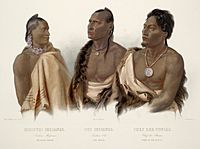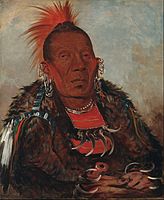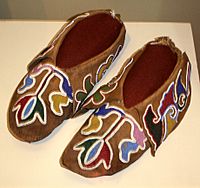Otoe–Missouria Tribe of Indians facts for kids

Tribal flag
|
|
| Total population | |
|---|---|
| 3,049 (2011) | |
| Regions with significant populations | |
| Oklahoma, United States | |
| Languages | |
| Chiwere language, English | |
| Religion | |
| tribal religion, Native American Church, Christianity | |
| Related ethnic groups | |
| Otoe, Missouria, Ho-Chunk, Iowa, and other Siouan peoples |
The Otoe–Missouria Tribe of Indians is a federally recognized tribe located in Oklahoma. This means the United States government officially recognizes them as a sovereign Native American nation. The tribe is made up of the Otoe and Missouria peoples. Their language, the Chiwere language, is part of the Siouan language family.
Contents
History of the Otoe–Missouria Tribe
The Otoe and Missouria tribes originally came from Wisconsin in the Great Lakes region. Long ago, they were part of a larger group that also included the ancestors of the Ho-Chunk, Winnebago, and Iowa tribes.
Early Migrations and European Contact
Around the 1500s, the Iowa, Otoe, and Missouria groups separated. They began moving south and west. By the late 1600s, the Missouria had settled near the Missouri and Grand rivers in what is now Missouri.
Meanwhile, the Otoe settled along the border of what is now Iowa and Minnesota. They first met Europeans in the late 1600s. A French explorer named Jacques Marquette showed them on a map in 1673. He placed the Otoe near the Des Moines and upper Iowa rivers. In 1700, another explorer, Pierre Le Moyne d'Iberville, wrote that the Otoe and Iowa lived with the Omaha tribe. Their territory was west of the Mississippi and Missouri rivers.
As more European-Americans arrived, the tribes moved to what is now Nebraska. They settled near the Platte River. This area later became the Otoe Reservation for them.
Challenges and Joining Forces
During the 1700s, the Missouria people faced many challenges. New diseases, like smallpox, spread and sadly killed many tribal members. They also lost people in frequent battles with enemy tribes, such as the Sac and Fox. In 1796, some Missouria survivors joined the Osage and Kaw tribes. About 80 Missouria joined the Otoe.
Traditional Life and Society
In the 1800s, the Missouria and Otoe tribes lived in permanent villages. Their homes were mostly earth lodges, but they also used tipis and bark lodges sometimes. Their society was patrilineal, meaning family lines were traced through the father. It had seven to ten clans, and each clan had special jobs. Tribal members had to marry someone from a different clan.
Each clan had a leader. These clan chiefs formed a tribal council. Traditionally, the chief of the Bear Clan was the main leader of the tribes. Men in the tribe hunted buffalo. Women prepared the meat and used animal parts like hides, bones, and horns for tools, clothing, and other items. They also grew and prepared crops like squash, beans, corn, and pumpkins.
Population Changes
In 1804, the Lewis and Clark Expedition estimated the Otoe–Missouria population to be about 500 people. Artist George Catlin, who visited their territory in 1833, estimated their population at 1,200. By 1830, about 1,500 Otoe–Missouria lived together. However, by 1886, only 334 Otoe–Missouria people remained.
Treaties and Land Loss
The Otoe–Missouria signed their first land treaty with the United States in 1830. More treaties followed in 1833, 1836, and 1854. The 1854 treaty created a reservation for them on the Kansas-Nebraska border, near the Big Blue River.
The tribe then split into two groups: those who wanted to adopt American ways (assimilationists) and those who wanted to keep their traditional ways (traditionalists). Quaker missionaries influenced the assimilationist group, who became known as the Quaker Band. The traditionalists were called the Coyote Band.
In 1876, the U.S. Congress arranged to sell a large part of the Otoe–Missouria reservation. The rest was sold in 1881. Congress then forced the Otoe–Missouria to move to Indian Territory (which is now Oklahoma). The Coyote Band settled on the Sac and Fox reservation. The Quaker Band settled on their own small reservation in what is now Noble and Pawnee counties.
Later, the Coyote Band rejoined the Quaker Band. But in the 1890s, under the Dawes Act, their shared reservation land was divided into individual plots for families. Any land left over after this division was sold to non-Native Americans. A total of 514 Otoe–Missouria people received individual land plots. In the mid-1900s, the Otoe–Missouria people asked for payment for their lands lost in the 1800s. Their request was approved, and they received a settlement in the 1960s.
Modern Tribal Government
The tribe approved its own constitution in 1984. This was done under the Oklahoma Indian Welfare Act. In 2009, the Environmental Protection Agency gave the tribe money for a water quality program. In 2020, the tribe received a grant from the U.S. Department of Housing and Urban Development to help with community development.
Economic Development
The Otoe–Missouria Tribe works hard to create economic opportunities for its members. They have their own housing authority and issue tribal vehicle tags for cars.
Tribal Businesses
The tribe owns several businesses. These include two gas stations, two smoke shops, two financial services companies, and five casinos. The tribe's economic activities bring in about $156.30 million each year.
Their casinos are 7 Clans Paradise Casino in Red Rock, First Council Casino in Newkirk, Lil' Bit of Paradise Casino—Chilocco (also in Newkirk), and Lil' Bit of Paradise Casino—Red Rock (in Red Rock). A new casino opened in Perry, Oklahoma, in May 2016. The tribe also works with other tribes to operate a wind farm.
Financial Ventures
In 2010, the tribe partnered with MacFarlane Group to create a tribal lending company called American Web Loan. The tribe's chairman, John Shotton, said this company was very important for the tribe's finances. In October 2016, the tribe bought the MacFarlane Group for $200 million. Through this partnership, the tribe received about one percent of the revenue as a royalty payment.
In 2021, the company settled a class action lawsuit regarding its lending practices for $182 million. This included $86 million in cash and $76 million in loan cancellations.
Community Financial Services
On May 20, 2019, the National Credit Union Administration approved a federal credit union for the Otoe-Missouria Tribe. The Otoe-Missouria Federal Credit Union is located in Red Rock, Oklahoma. It serves about 4,200 members and employees of the Otoe-Missouria Tribe.
Experts have found that the tribe's efforts to grow its economy have had a huge positive impact on Oklahoma and nearby areas. This includes over $45 million paid directly to employees across the tribe's various businesses.
Language and Culture
Only a few tribal members still speak the Otoe or Chiwere language. However, the tribe has a special program to bring the language back. Language classes are held every week in Edmond, Oklahoma.
For almost 150 years, since 1881, the Otoe–Missouria have held an annual Encampment. This event takes place every third weekend in July near Red Rock, Oklahoma.
The Otoe-Missouria tribe's history and culture are well shown at the First Americans Museum in Oklahoma City. Several tribal members worked with the museum to make sure their culture was presented accurately.
Education
In August 2019, the Otoe–Missouria Tribe was one of several tribes that officially supported Bacone College in Muskogee, Oklahoma. This made Bacone College a tribal college.
The tribes took control of the college to help it get federal funding and become financially stable. The college had faced money problems. Taking control also allowed the tribes to guide the curriculum to better serve their students' needs. Bacone College was originally started in the 1800s by the Baptist Church to educate Native American students.
Gallery
-
Missouria Indian, Otoe Indian, and Chief of the Ponca, by Karl Bodmer
-
Painting of Wah-ro-née-sah (The Surrounder), Otoe chief, painted by George Catlin, 1832
-
Otoe–Missouria men's moccasins, ca. 1880, Oklahoma, Oklahoma History Center
Notable Otoe–Missouria people
- Annette Arkeketa, author
- Benjamin Arkeketa (1928–2002), painter
- Johny Hendricks, former UFC fighter.
- Anna Lee Walters (b. 1946), author and publisher
- Truman Washington Dailey (1898–1996), fluent language speaker, traditionalist




